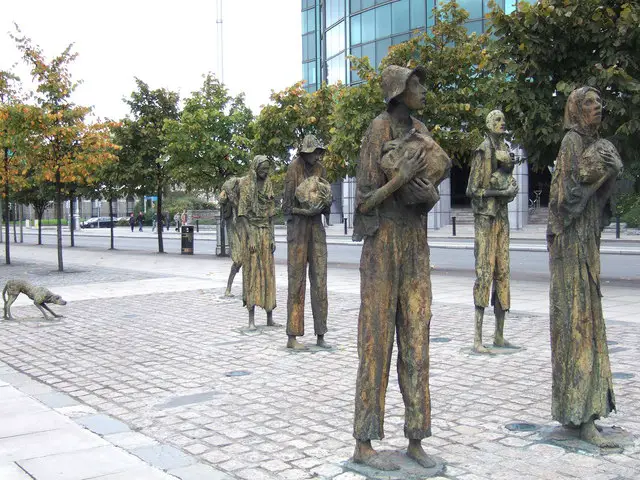The Potato Famine in Ireland goes by many names.
Sometimes known as the Potato Famine, the Great Famine, or the Great Hunger, it left a legacy in Ireland that is still felt here on the island today.
Did you know that the Irish population still hasn’t recovered to pre-famine levels? The current population residing on the island (including Northern Ireland) sits at approximately 7 million people, but before the famine the population was 8.5 million people!
Let’s look at when it happened, and some of the key facts behind this tragic period of Irish history.
When was the Potato Famine in Ireland?
The famine specifically took place between 1845 and 1852.
During these years, at the midway point of the 19th century, the impacts of the famine rose and fell with the plight of the potato crop. Potatoes, now a national staple and a food closely connected with Ireland, were originally imported to the country through port trade, and quickly became a key ingredient in the national diet.
This was largely due to a land-owning class utilising a cheap crop to feed the masses of poor tenants who made up the bulk of the Irish population.
Living was focused on subsistence, and when the crop repeatedly failed, millions of men, women and children instantly became vulnerable.
Irish Famine Facts & Statistics:
The famine in Ireland, often referred to as the Irish Potato Famine or the Great Famine, occurred between 1845 and 1852 and, whilst we can’t list every specific detail, here are a few important facts to remember:
- Causes: The primary cause of the famine was the failure of the potato crop, which was the staple food for a significant portion of the Irish population. The potato blight, caused by a fungus called Phytophthora infestans, destroyed the potato crops year after year. It essentially rotted the potato crop underground.
- Dependency on potatoes: The Irish population was heavily reliant on potatoes as a source of food due to their low cost and high yield. The failure of the potato crop had a catastrophic impact on the population’s food supply.
- Impact on population: The famine resulted in a significant loss of life and mass emigration. It’s estimated that the population of Ireland, which was around 8 million before the famine, decreased by approximately 1 million due to death and 1.5 million due to emigration.
- Death toll: The exact number of deaths is difficult to determine, but it is estimated that approximately 1 million people died during the famine. This represents about 12% of the pre-famine population.
- Emigration: The famine forced many Irish people to emigrate in search of a better life. Large numbers of people left Ireland, with the majority heading to the United States, Canada, Australia and England. This mass emigration had a lasting impact on Irish communities abroad and is largely the reason for the massive worldwide Irish diaspora.
- British response: The British government, which controlled Ireland at the time both in a governmental sense, and also due to close connections with the land-owning class previously mentioned, implemented relief measures to address the crisis, but only after significant pressure both internally and abroad. The response was considered inadequate and criticised for being slow and insufficient, exacerbating the suffering of the Irish population.
- Political and social consequences: The famine had profound political and social consequences. It contributed to a sense of Irish nationalism and resentment towards British rule that, amongst many other reasons, would eventually result in the Easter Rising of 1916 and the eventual formation of a new Irish State. It also exposed the deep-rooted socio-economic problems in Ireland, including land ownership issues and the vulnerability of tenant farmers.
- Land tenure system: The famine highlighted the flaws in Ireland’s land tenure system, known as the “landlord-tenant” system. Many tenant farmers were evicted from their land during the famine, exacerbating the social and economic hardships they faced.
- Poor relief efforts: The Poor Law was in place during the famine, but the workhouses established under this law were often overcrowded and disease-ridden and providing inadequate relief to those in need.
- Long-term consequences: The effects of the famine were long-lasting. The population of Ireland continued to decline well into the 20th century. The event has left a deep scar on Irish history and is still widely referenced to this day.
It’s important to remember that the Irish Famine was the result of a perfect storm of socio-economic situations, over-reliance on one crop, poor weather conditions, and many other factors.
There wasn’t one defining factor, and likewise the Irish Famine wasn’t the only influence in the eventual rise in support of an Irish Republic state separate from Great Britain.
Even today, 20+ years into the 21st century, the Famine is still considered possibly the darkest moment in Irish history. From the famine villages of Donegal in the north, to the infamous port of Cobh (where many Irish, escaping from the famine, caught a last glimpse of their homeland) on the southern tip of the island in Cork, the event has left an indelible mark on the Emerald Isle and will always be remembered.

